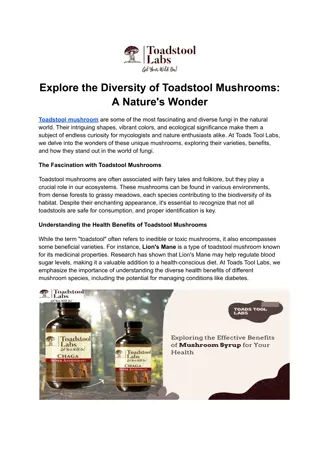Understanding Mycorrhiza: Types, Importance, and Classification
Mycorrhiza is a symbiotic association between fungi and plant roots crucial for plant survival. Around 95% of plant species form mycorrhizal relationships, with mycorrhizae existing since the earliest land plants. Classification includes Ectomycorrhiza and Endomycorrhiza based on tropic levels. Ectomycorrhiza, like EM, involve woody plants and specific fungi, enhancing root surface area and nutrient exchange. Mycorrhizal associations play a vital role in plant development and ecosystem health.
Download Presentation

Please find below an Image/Link to download the presentation.
The content on the website is provided AS IS for your information and personal use only. It may not be sold, licensed, or shared on other websites without obtaining consent from the author. Download presentation by click this link. If you encounter any issues during the download, it is possible that the publisher has removed the file from their server.
E N D
Presentation Transcript
Mycorrhiza Introduction, Types & Characterization,
MYCORRHIZA The word mycorrhiza was coined by the German scientist Albert Bernhard Frank in 1885. The word mycorrhiza is derived from the Greek words mukes meaning fungus and rhiza meaning roots. Mycorrhiza (fungus-root) can be defined as a symbiotic association between fungi and plant roots.
Importance 95% of all the world's plant species form mycorrhizal relationships with fungi and that in the majority of cases the plant would not survive without them. Present in 95% of plants (83% Dicots, 79% Monocots and 100% Gymnosperms). Brassicaceae, Cyperaceae, and Juncaceae- do not have mycorrhizal associations (10-20%). The Orchidaceae are notorious as a family in which the absence of the correct mycorrhizae is fatal even to germinating seeds
Importance Mycorrhizae have existed for a very long time and can be demonstrated in the fossilized roots of some of the earliest land plants. Some scientists have suggested that plants were only able to move on to land when they had developed mycorrhizal relationships with fungi.
Classification ofmycorrhiza Based on tropic level by A.B.Frank Ectotropic Mycorrhiza Endotropic Mycorrhiza Based on morphological and anatomical feature Ectomycorrhiza Endomycorrhiza Ectendomycorrhiza
Ectomycorrhiza or ectotrophic mycorrhiza (EcM) Ectomycorrhizas, or EM, are typically formed between the roots of around 10% of plant families, mostly woody plants including the birch, dipterocarp, eucalyptus, oak, pine, deodar and rose families , orchids, and fungi belonging to the Basidiomycota, Ascomycota and Zygomycota. Commonly associated with trans temperate forest trees.
Ectomycorrhizal fungi form a sheath or mantle around the root, and hyphae emanate through the soil increasing the surface area. The fungus grows within the root cell wall but never penetrates the cell interior. It grows between the cells of the cortex to form Hartig net. The Hartig net present outside the endodermis and meristematic zones is the site for nutrient exchange. Colonization of root tips induces marked changes in the host root morphology.
Fungus forming ectomycorrhizae Amanita muscaria Boletus variegatus Paxillus invalutus Rhizopogon vinicolor Entomoloma Sclerodendran Amanita muscaria Entomoloma
Advantages of ectomycorrhiza Extensive multibranching hyphae increases the water holding capacity of plants. Increase the tolerance to drought, high soil temperature, organic and inorganic soil toxins, extremes of soil acidity to sulphur and aluminium. Deter infection of feeder roots by some rot pathogens. Enhance the uptake of many nutrients. (P, Cu, Zn through Hartig net) Disease control through barrier effect, competitive exclusion. Play a key role in afforestation.
Endomycorrhiza or endotrophic mycorrhiza Arbuscular mycorrhizae (often called AM) are the mostcommon and widespread of all mycorrhizae and are found in as many as 85%-90% of the world's plant species. Commonly associated with agricultural, horticulture crops in addition to tropical trees.
The external hyphal mantle or sheath is absent or scanty. The fungal hyphae enters inside the root cortex and penetrates the cortical cells. This is not a destructive parasitic association but endomycorrhiza are present at certain times as a part of normal root development. AM fungi penetrate the cell walls of root cells. They grow between the cell wall and cell membrane forming arbuscules. VAM fungi produce vesicles for lipid storage.
Two main types of root colonization in arbuscular mycorrhizae (AM). 1: extraradical hyphae; 2: appressorium/hyphopodium; 3: arbusculum; 4: vesiculum; 5: intercellular hyphae; 6: intracellular hyphae; 7: hyphal coils.
Two main types of root colonization in arbuscular mycorrhizae (AM). In the Arum-type the fungal hyphae grow intercellularly and well-developed arbuscules are formed on branches entering the neighboring cells. In the Paris-type the hyphae grow intracellularly, develop hyphal coils in some cortical cells and smaller arbuscules develop on these coils. Both the fungal and the plant partner influence the type developed
Fungi formingendomycorrhizae Endogone Glomus Sclerocystis Acaulospora Gigaspora Enterophophora Scutellispora Glomus Gigaspora
Endomycorrhizae Generally fungi produce its typical structures, vescicles and arbuscules inside the root system. Commonly associated with agricultural, horticulturaland tropical trees. Have a loose network of hyphae in the soil and an extensive growth within the cortex cells of the plants. Cannot be cultured on artificial media. Doesn t cause morphological changes in roots. Ectomycorrhizae Fungi produce majority of its structure outside the root system. Commonly associated with trans temperate forest tree roots. Form a complete mantle or sheath over the surface of the rot and hyphae grows out into thesoil. Can be cultured on artificial media. Cause morphological changesin roots.























